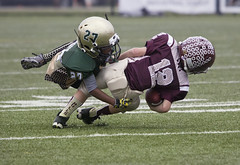Public attitudes and knowledge about youth sports participation and concussion risk in an urban area
Taranto E, Fishman M, Garvey K, Perlman M, Benjamin HJ, and Ross LF. J Natl Med Assoc. 2018. [Epub Ahead of Print].
https://www.ncbi.nlm.nih.gov/pubmed/30376961
Take Home Message: Seventy-four percent of a surveyed people in an urban area reported that it is proper for physicians to counsel against youth participation in full-contact sports. Furthermore, 46% would still allow their child to participate in football.
As youth participation in sports increases, so to have the number of sports-related concussions in the youth population. Authors of a recent study of parents with children in youth sports showed that while overall about 70% of parents felt children should start playing contact sports under 10 years of age, only 37% of parents with kids in noncontact sports agreed. An important limitation of this study was that it failed to include all adults, which may include parents who decided that their child should not participate in sports. Understanding people’s knowledge and attitudes of concussion is a critical step in understanding how to promote physical activity and best intervene and protect youth sports participants from sustaining a concussion. To address this knowledge gap, Taranto and colleagues completed a survey study to examine the attitudes and knowledge of adults in the Chicago area about full-contact youth sports, concussions, and the role of physicians. A convenience sample of 1,091 adults completed a 35 question survey. Respondents were at least 18 years old and English speaking. The authors collected data at 3 locations in the city of Chicago. The survey asked hypothetical questions regarding the reaction to a 10-year old child wanting to participate in a full-contact sport. Questions about children who had previously suffered concussions were limited to respondents who were parents. Overall, 74% of respondents agreed that it would be proper for a physician to counsel against youth full-contact sports. About half (46%) would allow a 10-year old boy to play tackle football. Further, 67% of respondents with children, allowed at least 1 of their children to take part in a contact sport in high school; however, 26% said that if given the choice now, they would have prohibited their child from participating. To gather information about concussion, most respondents (46%) stated using news media as their main source of information, while sports media (36%) followed by physicians (34%) were other common sources.
The authors of this study found that parents may be changing their view of contact sports and concussions. This was best showed by the 26% of respondents who replied that given more information than when their child participated in sports they would now discourage or not allow their child to play a full-contact sport. Also of interest, while 74% of respondents reported that it was proper for physicians to counsel against participation in full-contact youth sports, only 54% would prohibit their child from participating. This shows a gap that some parents may be aware of the risks of concussion and contact sports, but that awareness was insufficient to actively prevent their child from taking part in the activity. This is interesting as many respondents reported that they sought information on concussion from potentially less reputable resources than medical professionals. While interesting, there should be caution taken while interpreting these results. The most significant limitation of this study was the inclusion of respondents who did not have children (25% of all respondents). This is challenging as these respondents have not yet had to truly evaluate their level of comfort with allowing a child to take part in a contact sport. Furthermore, this group of respondents has also not been put into a situation in which they have had to seek out information about concussion or sports for their child and therefore could be more likely to allow children to participate. To truly understand this research question, future research should look to include only respondents who have a child. In the meantime, clinicians need to be proactive in educating their parents and athletes about the benefits and harms associated with sports participation so that they can make an informed decision.
Questions for Discussion: How do you educate athletes and parents about the dangers of youth concussions?
Do you feel that public knowledge of concussion has improved in recent years?
Written by: Kyle Harris
Reviewed by: Jeffrey Driban
Related Posts:
Are Football Related Concussions Causing a Behavioral Shift Away From Participation?
Give a Heads Up to Your Club Sports on Concussions
Parents,Where are You Getting Your Concussion Information?
When it Comes to Chronic Traumatic Encephalopathy (CTE): Perhaps Mother Doesn’t Know Best


This is a really cool article, I found it really interesting that a lot of parents changed their mind about allowing their child to participant in contact sports. I think this raises a question as to just how much parents actually know about concussions. I think it would be really interesting to see a study that assesses parent concussion knowledge.
I would also like to see how much youth coaches and parents know about proper equipment fitting. Improperly fitted equipment could be a contributing factor in concussions. Since a lot of youth sports coaches are parents I would be curious to see their knowledge of equipment fitting
Jacob,
Thanks for the comment. You bring up some really excellent points. I enjoyed this article a lot, but I was really troubled by the inclusion of people that did not have children. I think this really muddies the water so to speak. I think both of the populations you indicated should be assessed, but again, the methods of the study would be critical. Have you had any experiences with educating parents about concussions? If so, what have your experiences been?
Thanks,
Kyle